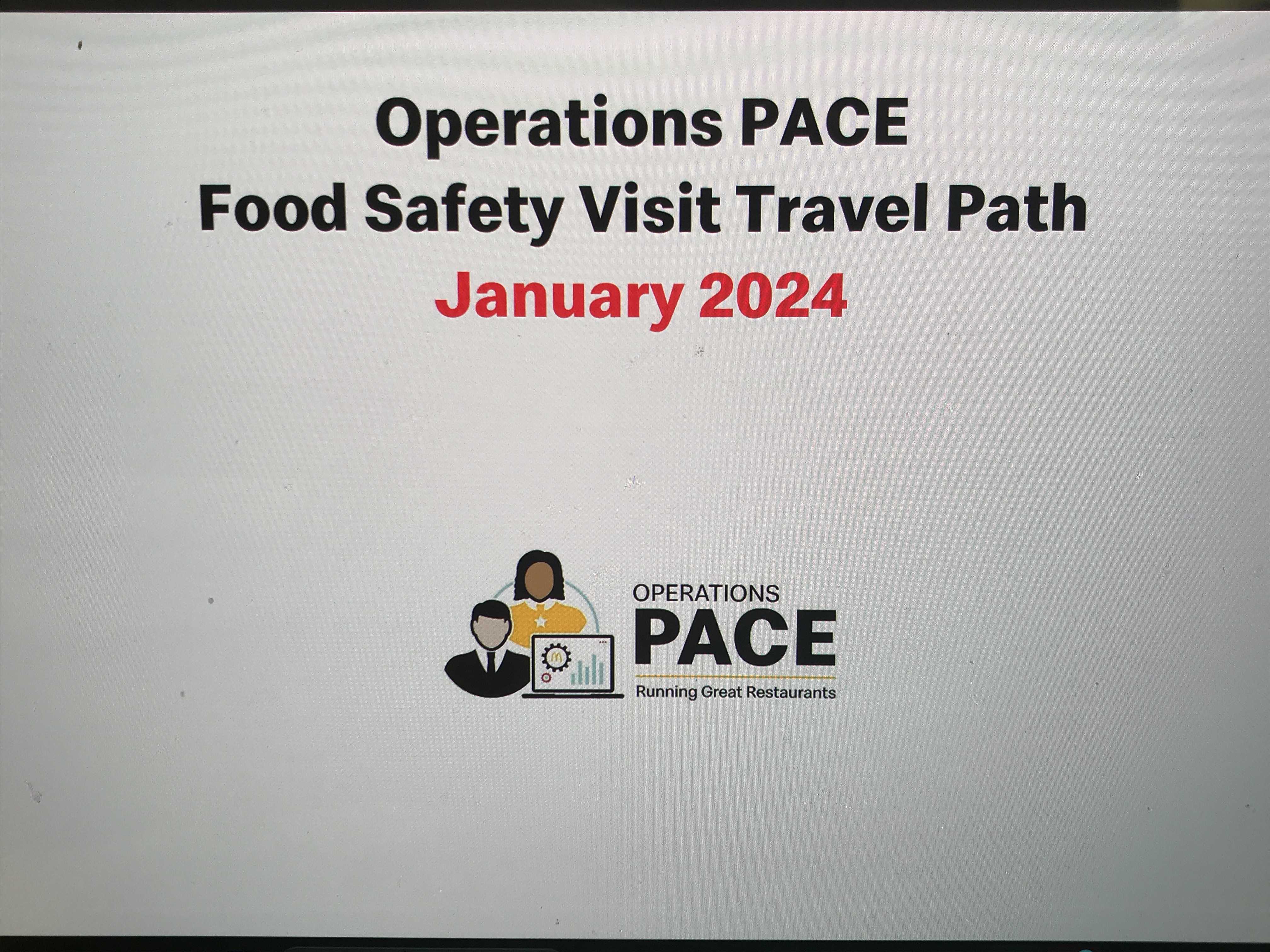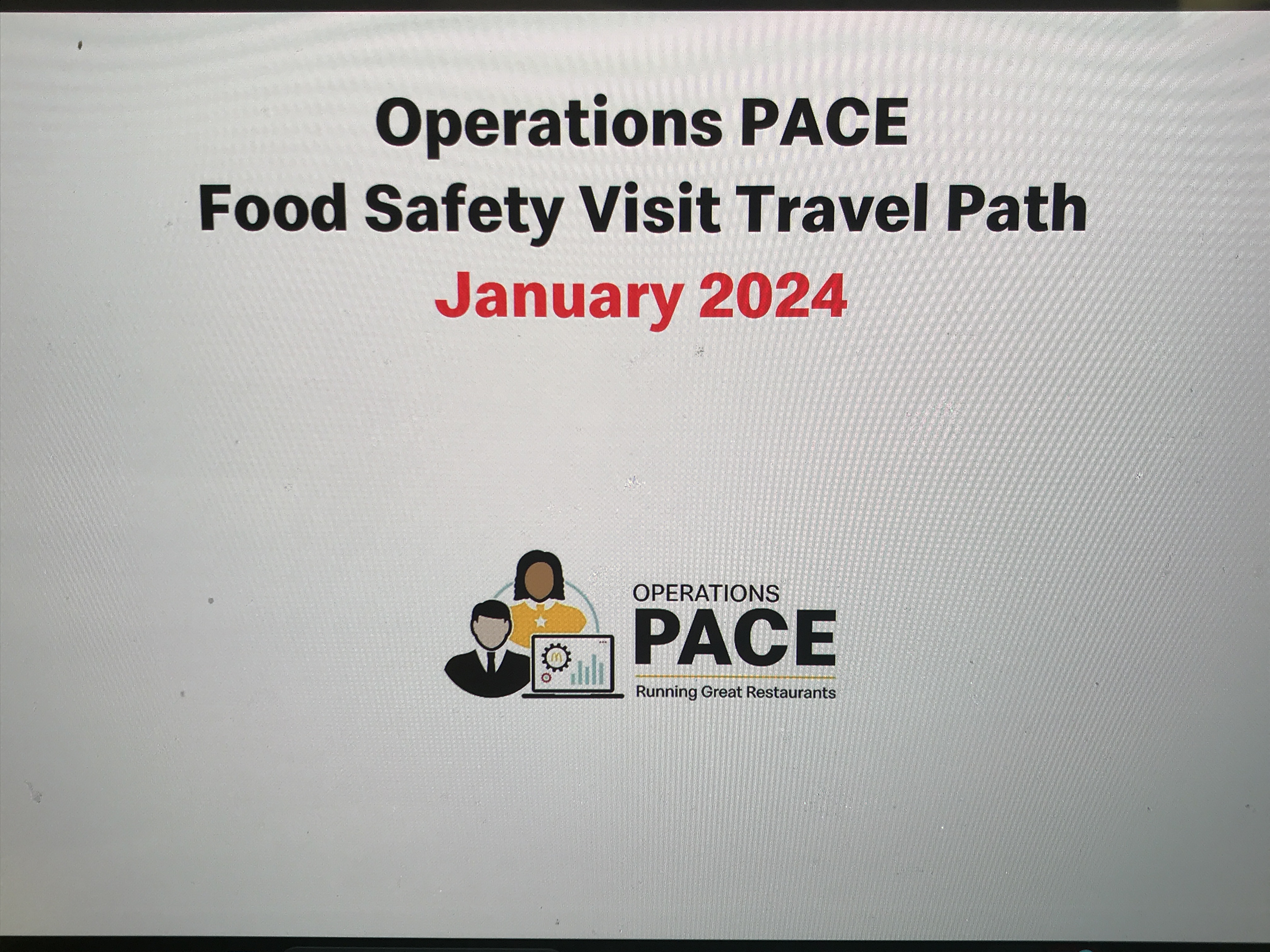Title Page
-
Store Name
-
Site conducted
-
Conducted on
-
Manager on Duty
-
Prepared by
-
Location
Food Safety Visit Travel Path
Introduction and Knowledge Check Questions
Symptoms/Illnesses
-
1. Without referencing materials, what are the symptoms of when<br>an employee cannot work? The manager must recall all<br>symptoms:<br>• Vomiting<br>• Diarrhea<br>• Jaundice<br>• A sore throat with fever<br>• Has a lesion containing pus such as<br>a boil or infected wound that is open<br>or draining that is not properly<br>covered or protected
-
2. What are the reportable illnesses? Managers may reference<br>materials, if available:<br>• Salmonella<br>Nontyphoidal<br>Typhoid fever (caused<br>by Salmonella<br>Typhi)<br>• Shigella<br>• Hepatitis A Virus<br>• Norovirus<br>• E. Coli (Shiga toxin-producing)
-
When can an ill employee return to work?
Documentation
-
Discuss documentation that will be reviewed at the end of the visit <br>□ For Paper Food Safety Records: Last 60 days of completed<br>Daily Food Safety Checklists<br>□ For Digital Food Safety Records: Food Safety Daily Checklist<br>completion percentage (should be above 80%)<br>□ Last two Monthly Food Safety Procedures Verifications<br>□ Pest Management Service Report<br>□ Procedures for non-food spill clean-up<br>□ ServSafe or equivalent certificates for all managers<br>□ Records or tracking for food safety training of all employees<br>□ The last Health Department Inspection Report<br>□ Previous EcoSure Report<br>
-
Second pyrometer Available
-
□ Ask about hourly handwashing procedures and when the next<br>handwashing will begin
-
Ask about the process for cleaning UHC trays and utensils every<br>four hours
Conducting the Review
-
3. Hand Sink Areas (check all hand sinks and towel buckets)
-
□ Wash hands It is important to model good handwashing behavior as you will be<br>contacting food/food contact supplies during your review.<br>□ Check supplies (check all hand wash sinks)<br>□ Check that warm water is available (check all hand wash sinks)<br>□ Hand sinks are easily accessible<br>□ Measure sanitizer concentration in all clean towel buckets The chlorine test strip is used to confirm that the sanitizer<br>concentration is at 50 ppm or above
Ice Machine Area
-
Assess ice machine, ice chutes, ice bins, ice scoops & transfer bucket
-
Check floor and drains for standing or puddling water
-
Verify pyrometer calibration
5. Refrigerated Areas
-
Refrigerated Areas (Check the two most frequently used reach-in refrigerators and freezers)
-
Ensure freezers are operating properly and that items are solidly frozen
-
Check that refrigerated products are at or below a temperature of 40°F.
-
Check that primary/secondary shelf lives are in code
6. Prep Area/Grill/Fryer/Prep Table Area
-
Assess employee behaviors (hand washing and glove use) and personal hygiene procedures
-
No excessive jewelry on hands and wrists (more than a smooth ring/wedding band)
-
hair/beard cover are used properly to prevent product contamination
-
No false and/or dirty fingernails
-
Chemicals stored away from food and packaging
-
Sanitized towels are not left sitting out on surfaces
-
Proper use of blue gloves and dedicated utensils used to prevent cross-contamination
-
Proper use of clear/white gloves
-
Check that all produce, cheese and melted butter at prep table is marked with a secondary shelf life and is not expired
-
Check utensils and UHC trays for cleanliness and no build-up and for condition (not cracked or damaged)
-
Check fryer baskets for loose wires
-
Check the internal temperature of 10:1, 4:1, Crispy Chicken, Filet-O-Fish, Round Egg and Breakfast Sausage/Breakfast Steak, with the shift manager taking at least one set of beef temperatures (preferably 4:1)
-
It is not required to check every product in a protein category, however, if the restaurant cooks other products during your visit, evaluate the product temperature
-
Check the internal temperature of 3 TCS foods in hot holding
-
Check under grills and fryers for excessive build-up or signs of pests
-
Managers know how to correctly complete food safety checks
7. Back Sink Area
-
Check for hot water 110°F or higher
-
Check that back sink functions with all required supplies
-
Measure sanitizer concentration of sanitizer solution at back sink Quat test strip to confirm that the concentration is at 200 ppm or above
-
Check warewasher (if used) function and measure sanitizer concentration
-
Check function of soap and sanitizer dispensers
-
Raw meat utensils washed separate and washed last
-
Floors, walls, ceilings, and equipment in good repair
-
Check floors for puddling water, missing tiles and signs of pests
8. Back of Restaurant (Storage Room & Walk-ins)
-
Evaluate walk-in refrigerator (take product temperatures) and freezer (read air temperature)
-
Check to see if food is covered/wrapped and stored properly
-
Check primary and secondary shelf lives of products in walk-in refrigerator (focus on produce, fresh beef, and chicken)
-
Check for any previously heated foods being saved
-
Check for approved food products and chemicals stored away from food packaging
-
Check for signs of pest infestation or for exterior pest entry points
-
Check water filters (If on Coke Program, mark yes)
-
Floors, walls, ceilings, and equipment clean and in good repair
9. Front counter/self-serve beverage area
-
Check towel buckets
-
Chemicals stored away from food
-
Ice chutes are clean with no build-up
-
Orange container with a lid and dedicated scoop used for nut-containing mix-ins
-
Ask the Manager how they deal with a customer request for allergen information
-
The primary shelf life of milk and apples
-
Check under BIM machine for signs of build-up or pests
10. Restrooms
-
Check handwashing sinks (supplies and warm water)
-
All hand sinks must have warm water with at least 1 stocked soap Dispenser and hand towels/working hand dryer available
-
What is your system for ensuring that restrooms are cleaned at least every 2 hours?
-
Ask the Manager "When is the next time that restrooms are scheduled to be cleaned?Manager should be able to describe a system for ensuring restrooms are cleaned at least every 2 hours.
Exterior
-
Check for signs of pest infestation
-
Check corral
Communicate Results
-
Review outstanding documentation
-
Ask if they have questions on any item reviewed/cited in the visit.









